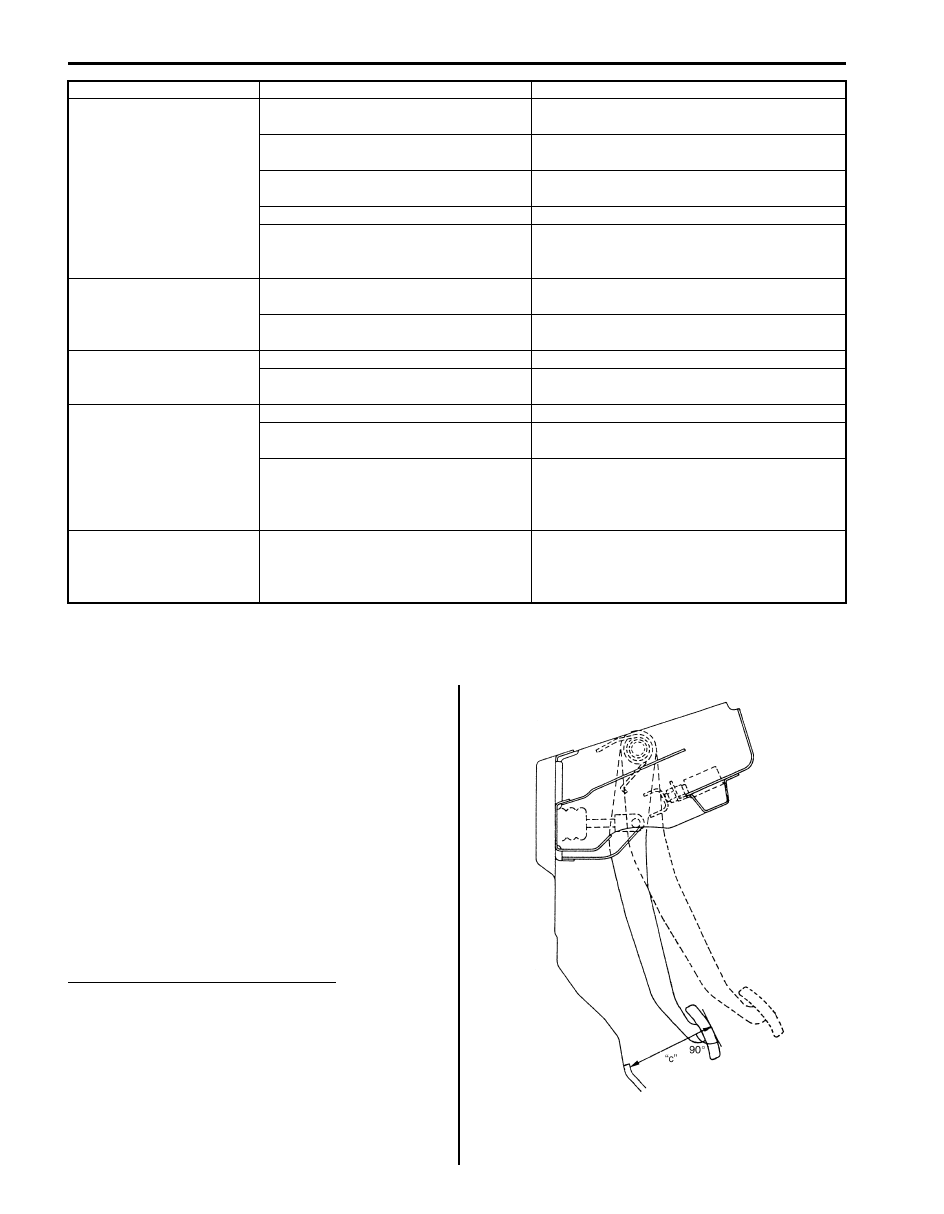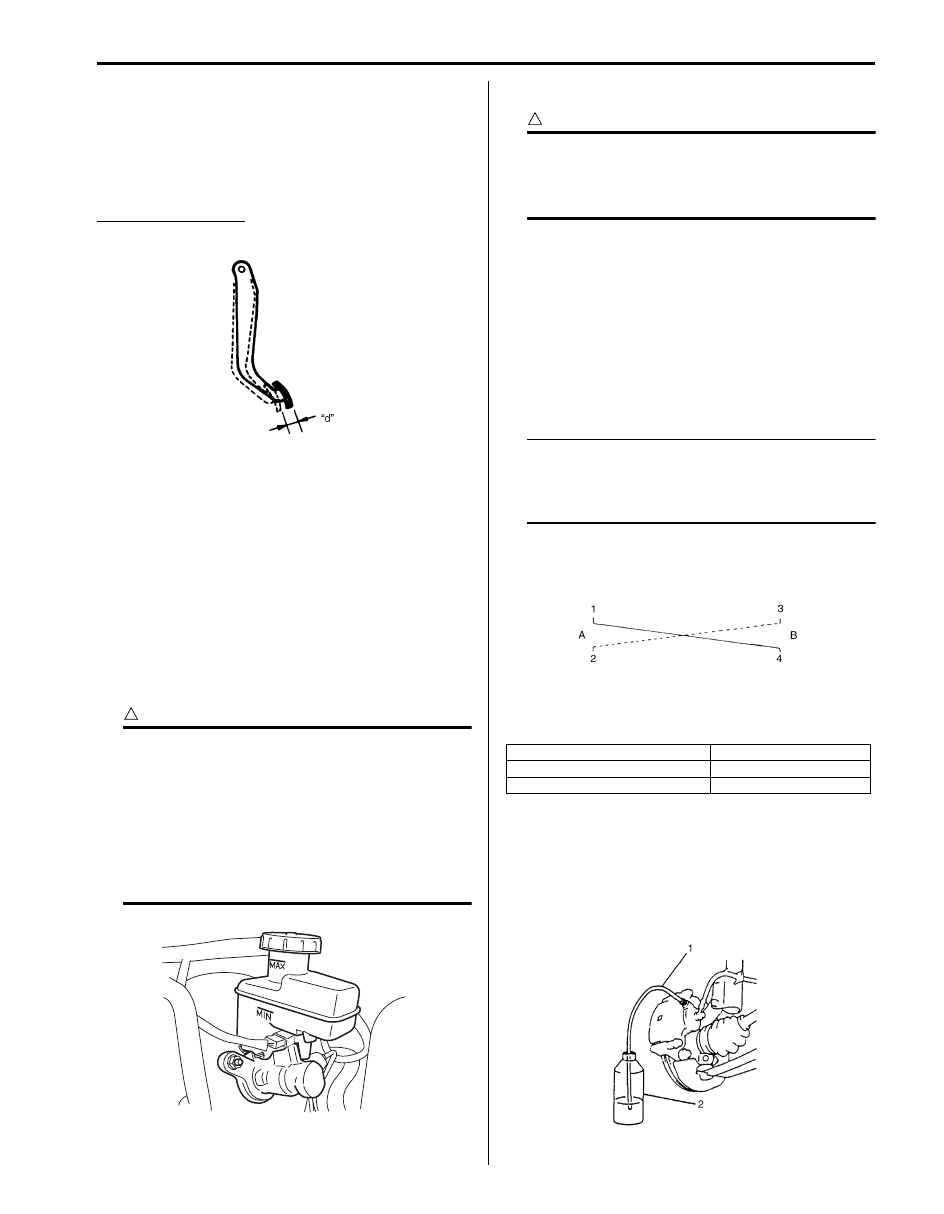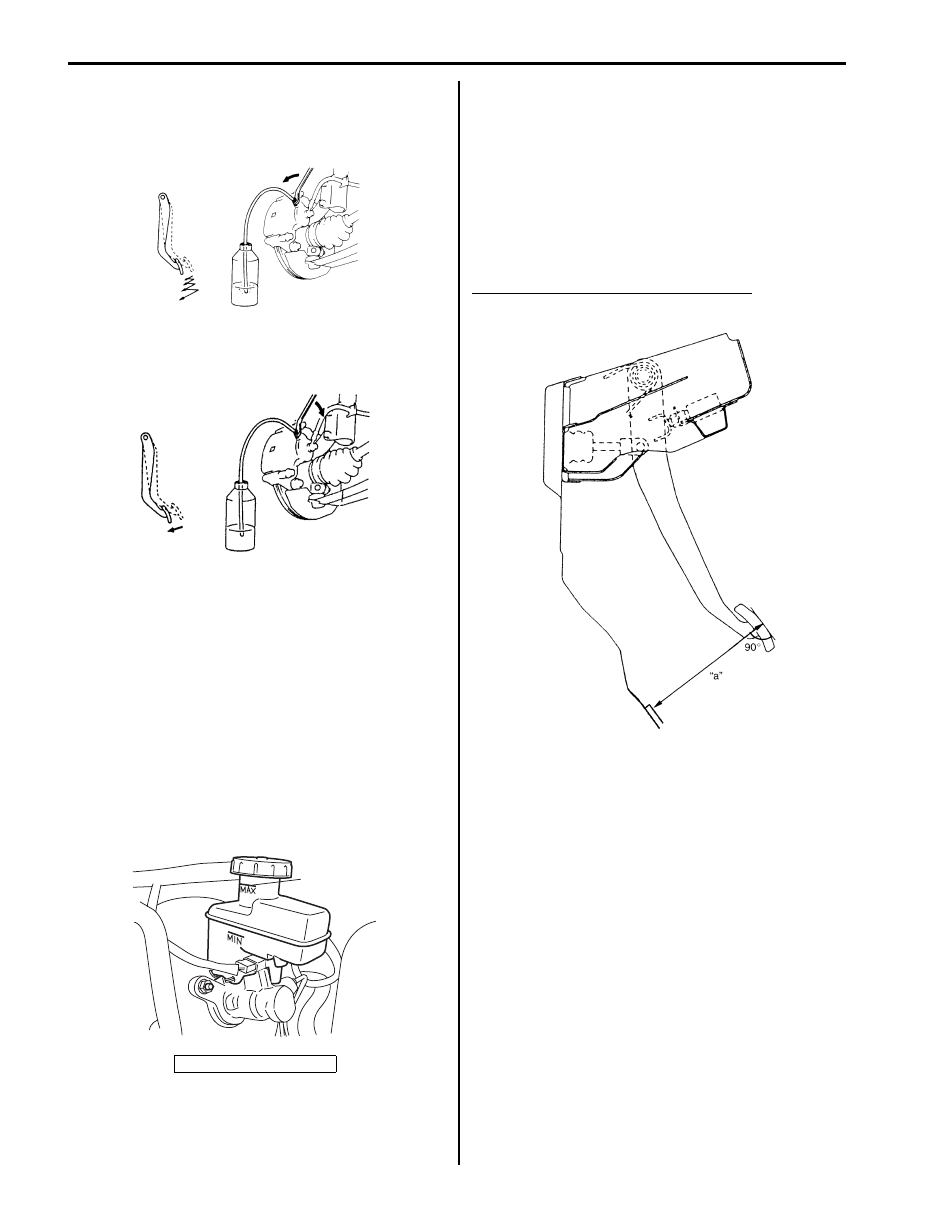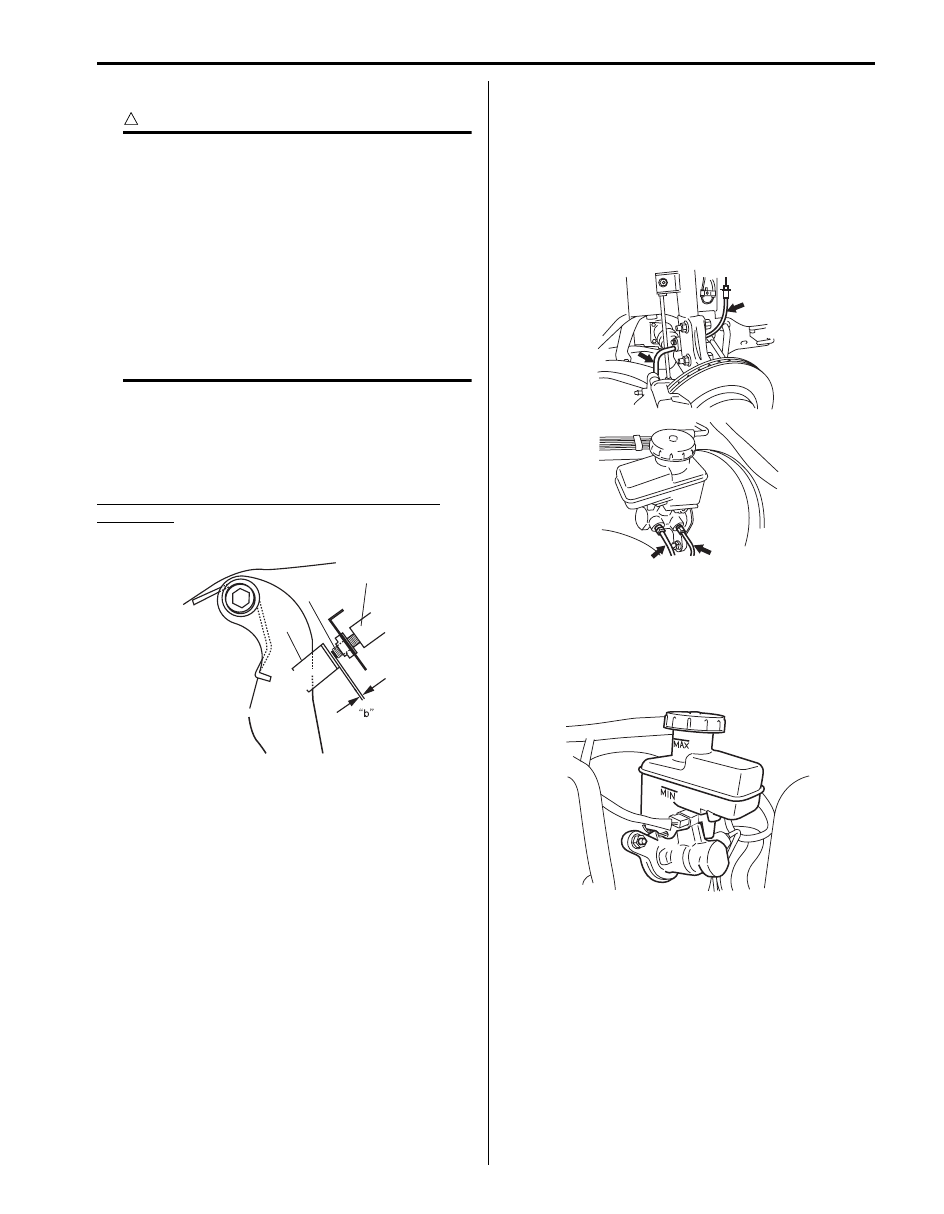Suzuki Grand Vitara JB627. Manual — part 172

4A-7 Brake Control System and Diagnosis:
Repair Instructions
Excessive Pedal Travel Check
S6JB0B4106001
1) Start engine.
2) Depress brake pedal a few times.
3) With brake pedal depressed with approximately 30
kg (66 lbs) load, measure pedal to carpet clearance
“c”.
If clearance “c” is less than specification, the most
possible cause is either rear brake shoes are worn
out beyond limit or air is in lines.
Should clearance “c” remain less than specification
even after replacement of brake shoes and bleeding
of system, other possible but infrequent cause is
malfunction of rear brake shoe adjusters or booster
push rod length out of adjustment.
Brake pedal arm to wall clearance “c”
When pedal depressed at 300 N (30 kg, 66 lbs): Over
70 mm (2.75 in.)
Brake warning light turns
ON after engine start
Parking brake applied
Release parking brake and check that brake
warning light turns off.
Insufficient amount of brake fluid
Investigate leaky point, correct it and add
brake fluid.
Brake fluid leaking from brake line
Investigate leaky point, correct it and add
brake fluid.
Brake warning light circuit faulty
Repair circuit.
Malfunctioning EBD system
Check system referring to “ABS Check in
Section 4E” or “ESP
Brake warning light turns
on when brake is applied
Brake fluid leaking from brake line
Investigate leaky point, correct it and add
brake fluid.
Insufficient amount of brake fluid
Investigate leaky point, correct it and add
brake fluid.
Brake warning light fails
to turn on even when
parking brake is applied
Bulb burnt out
Replace bulb.
Brake warning light circuit faulty
Repair circuit.
ABS warning light does
not turn ON for 2 – 3 sec.
after ignition switch has
turned ON
Bulb burnt out
Replace bulb.
ABS warning light circuit open (including
check relay)
Repair or replace.
Malfunctioning ABS (ESP
®)
Check system referring to “ABS Warning Light
Does Not Come ON at Ignition Switch ON in
Section 4E” or “ESP
Come ON at Ignition Switch ON in Section 4F”.
ABS warning light
remains ON after ignition
switch has turned ON for
2 – 3 sec.
Malfunctioning ABS (ESP
®)
Check system referring to “ABS Warning Light
Comes ON Steady in Section 4E” or “ESP
Warning Light Comes ON Steady in Section
4F”.
Condition
Possible cause
Correction / Reference Item
IYSQ01410009-01

Brake Control System and Diagnosis: 4A-8
Brake Pedal Play Check
S6JB0B4106002
Pedal play should be within specification. If out of
specification, check brake light switch for proper
installation position and adjust if necessary.
Also check pedal shaft bolt and master cylinder pin
installation for looseness and replace if defective.
Brake pedal play “d”
: 1 – 8 mm (0.04 – 0.32 in.)
Brake Fluid Level Check
S6JB0B4106003
Be sure to use particular brake fluid either as indicated
on reservoir cap of that vehicle or recommended in
owner’s manual which comes along with that vehicle.
Use of any other fluid is strictly prohibited.
Fluid level should be between MIN and MAX lines
marked on reservoir.
When warning light lights sometimes during driving,
replenish fluid to MAX line.
When fluid decreases quickly, inspect brake system for
leakage. Correct leaky points and then refill to specified
level.
CAUTION
!
Do not use shock absorber fluid or any other
fluid which contains mineral oil. Do not use a
container which has been used for mineral oil
or a container which is wet from water.
Mineral oil will cause swelling and distortion
of rubber parts in hydraulic brake system and
water mixed into brake fluid will lower fluid
boiling point. Keep all fluid containers
capped to prevent contamination.
Air Bleeding of Brake System
S6JB0B4106004
CAUTION
!
Brake fluid is extremely damaging to paint. If
fluid should accidentally touch painted
surface, immediately wipe fluid from paint
and clean painted surface.
Bleeding operation is necessary to remove air whenever
it entered hydraulic rake system.
Hydraulic lines of brake system are based on the
diagonal split system. When a brake pipe or hose was
disconnected at the wheel, bleeding operation must be
performed at both ends of the line of the removed pipe or
hose. When any joint part of the master cylinder of other
joint part between the master cylinder and each brake
(wheel) was removed, the hydraulic brake system must
be bled at all 4 wheel brakes.
NOTE
Perform bleeding operation starting with
wheel cylinder farthest from master cylinder
and then at front caliper of the same brake
line. Do the same on the other brake line.
1) Fill master cylinder reservoir with specified brake
fluid and keep at least one-half full of fluid during
bleeding operation.
2) Remove bleeder plug cap.
Attach a vinyl tube (1) to bleeder plug of wheel
cylinder, and insert the other end into container (2).
IYSQ01410010-01
I5JB0A410005-01
1. Right brake caliper
4. Left wheel cylinder
2. Left brake caliper
[A]: FRONT
3. Right wheel cylinder
[B]: REAR
I2RH01410013-01
I2RH01410015-01

4A-9 Brake Control System and Diagnosis:
3) Depress brake pedal several times, and then while
holding it depressed, loosen bleeder plug about one-
third to one half turn.
4) When fluid pressure in the cylinder is almost
depleted, retighten bleeder plug.
5) Repeat this operation until there are no more air
bubbles in hydraulic line.
6) When bubbles stop, depress and hold brake pedal
and tighten bleeder plug.
Tightening torque
Front brake caliper bleeder plug: 7 N·m (0.7 kgf-
m, 5.0 lb-ft)
Rear wheel cylinder bleeder plug: 7 N·m (0.7
kgf-m, 5.0 lb-ft)
7) Then attach bleeder plug cap.
8) After completing bleeding operation, apply fluid
pressure to pipe line and check for leakage.
9) Replenish fluid into reservoir up to “MAX” level.
10) Check brake pedal for “sponginess”. If found spongy,
repeat entire procedure of bleeding.
Brake Pedal Free Height Adjustment
S6JB0B4106005
Measure brake pedal free height between pedal and
carpet installed on dash panel.
If the measurement is not within the specification, check
the position of booster push rod clevis and/or brake light
switch, referring to, “Master Cylinder Assembly
Inspection”, “Booster Push Rod Clevis Adjustment” and/
or “Brake Light Switch Adjustment”. The free height
varies depending on installation position of booster push
rod clevis and brake light switch.
Brake pedal free height “a” from carpet
“a”: 131 – 141 mm (5.16 – 5.55 in.)
1. MAX level mark
I2RH01410016-01
I2RH01410017-01
1
I5JB0A410006-01
IYSQ01410007-01

Brake Control System and Diagnosis: 4A-10
Brake Light Switch Adjustment
S6JB0B4106006
CAUTION
!
Do not apply any oil or grease (including rust
preventives, lubricant, etc.) to following
sections.
* Brake light switch (1) (including its tip end)
* Switch (1) contacting section of brake pedal
stay (3)
Oil or grease, if applied, will enter the contact
point in the switch, causing contact failure.
Also, when checking, adjusting or replacing
brake switch, check that no oil or grease is
attached to switch contacting section on
brake pedal side or tip end of switch.
Wipe off oil or grease being attached.
Adjustment should be made as follows when installing
switch (1). Pull up brake pedal toward you and while
holding it there, adjust switch position so that clearance
between end of switch thread (2) and brake pedal stay
(3).
Clearance “b” between end of thread and brake
pedal stay
“b”: 1.5 – 2.5 mm (0.06 – 0.10 in.)
Brake Flexible Hose and Pipe Check
S6JB0B4106007
The brake hose assembly should be checked for road
hazard damage, for cracks and chafing of the flexible
hose, for leaks and blisters. A light and mirror may be
needed for an adequate inspection. If any of the above
conditions are observed on the brake flexible hose, it is
necessary to replace it.
Inspect the pipe for damage, cracks, dents and
corrosion. If any defect is found, replace it.
Master Cylinder Check
S6JB0B4106008
Check for a cracked master cylinder casting or brake
fluid around the master cylinder. Leaks are indicated
only if there is at least a drop of fluid. A damp condition is
not abnormal.
Flushing Brake Hydraulic System
S6JB0B4106009
It is recommended that entire hydraulic system be
thoroughly flushed with clean brake fluid whenever new
parts are installed in hydraulic system.
Periodical change of brake fluid is also recommended.
3
2
1
I3JA01410004-01
I5JB0A410007-01
I5JB0A410005-01

Нет комментариевНе стесняйтесь поделиться с нами вашим ценным мнением.
Текст